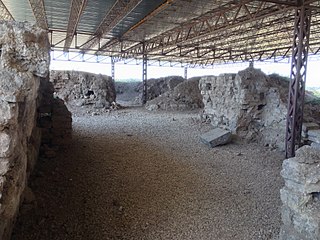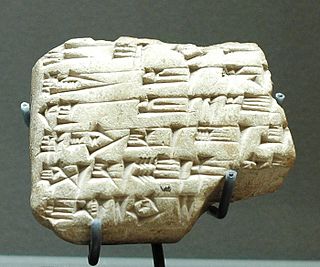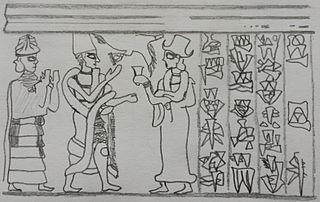Related Research Articles

Yamhad was an ancient Semitic-speaking kingdom centered on Ḥalab (Aleppo) in Syria. The kingdom emerged at the end of the 19th century BC and was ruled by the Yamhad dynasty, who counted on both military and diplomacy to expand their realm. From the beginning of its establishment, the kingdom withstood the aggressions of its neighbors Mari, Qatna and the Old Assyrian Empire, and was turned into the most powerful Syrian kingdom of its era through the actions of its king Yarim-Lim I. By the middle of the 18th century BC, most of Syria minus the south came under the authority of Yamhad, either as a direct possession or through vassalage, and for nearly a century and a half, Yamhad dominated northern, northwestern and eastern Syria, and had influence over small kingdoms in Mesopotamia at the borders of Elam. The kingdom was eventually destroyed by the Hittites, then annexed by Mitanni in the 16th century BC.

Qatna was an ancient city located in Homs Governorate, Syria. Its remains constitute a tell situated about 18 km (11 mi) northeast of Homs near the village of al-Mishrifeh. The city was an important center through most of the second millennium BC and in the first half of the first millennium BC. It contained one of the largest royal palaces of Bronze Age Syria and an intact royal tomb that has provided a great amount of archaeological evidence on the funerary habits of that period.

Carchemish, also spelled Karkemish was an important ancient capital in the northern part of the region of Syria. At times during its history the city was independent, but it was also part of the Mitanni, Hittite and Neo-Assyrian Empires. Today it is on the frontier between Turkey and Syria.

Alalakh is an ancient archaeological site approximately 20 kilometres (12 mi) northeast of Antakya in what is now Turkey's Hatay Province. It flourished, as an urban settlement, in the Middle and Late Bronze Age, c. 2000-1200 BC. The city contained palaces, temples, private houses and fortifications. The remains of Alalakh have formed an extensive mound covering around 22 hectares. In Late Bronze Age, Alalakh was the capital of the local kingdom of Mukiš.

Mari was an ancient Semitic city-state in modern-day Syria. Its remains form a tell 11 kilometers north-west of Abu Kamal on the Euphrates River western bank, some 120 kilometers southeast of Deir ez-Zor. It flourished as a trade center and hegemonic state between 2900 BC and 1759 BC. The city was built in the middle of the Euphrates trade routes between Sumer in the south and the Eblaite kingdom and the Levant in the west.

Shamshi-Adad, ruled c. 1808–1776 BC, was an Amorite warlord and conqueror who had conquered lands across much of Syria, Anatolia, and Upper Mesopotamia.

Yahdunlim was the king of Mari probably in 1820—1796 BC. He was of Amorite origin, and became king after the death of his father Iagitlim. Yahdunlim built Mari up to become one of the major powers of the region. He led a successful campaign to the coast of the Mediterranean.

Yasmah-Adad was the younger son of the Amorite king of Upper Mesopotamia, Shamshi-Adad I. He was put on throne of Mari by his father after a successful military attack following the assassination of Yahdun-Lim of Mari in 1796 B.C.E. He was responsible for the southwestern section of his father's kingdom including the Balikh River, Habur River, and Euphrates River. Yasmah-Adad's administrative district bordered the state of Yamkhad and the Syrian steppe. His father controlled the northern part of the kingdom from Shubat-Enlil, and his older brother, Ishme-Dagan, ruled over the southeast area from Ekallatum. Yasmah-Adad's leadership of Mari and the surrounding districts around the Euphrates ended when his father died, and the Amorite Zimri-Lim and his army chased him out of Mari and took his throne in 1775 B.C. The sources do not fully agree, but state that he was either chased out of his borders or killed before being allowed to flee.

The Royal Palace of Mari was the royal residence of the rulers of the ancient kingdom of Mari in eastern Syria. Situated centrally amidst Palestine, Syria, Babylon, Levant, and other Mesopotamian city-states, Mari acted as the “middle-man” to these larger, powerful kingdoms. Both the size and grand nature of the palace demonstrate the importance of Mari during its long history, though the most intriguing feature of the palace is the nearly 25,000 tablets found within the palace rooms. The royal palace was discovered in 1935, excavated with the rest of the city throughout the 1930s, and is considered one of the most important finds made at Mari. André Parrot led the excavations and was responsible for the discovery of the city and the palace. Thousands of clay tablets were discovered through the efforts of André Bianquis, who provided archaeologists the tools to learn about, and to understand, everyday life at the palace in Mari. The discovery of the tablets also aided in the labeling of various rooms in terms of their purpose and function.

Ibiranu was the sixth king of Ugarit, a city-state in northwestern Syria. Ibiranu reigned between c. 1235 and 1225/20 BC, and was a contemporary of Tudhaliya IV and Arnuwanda III of Hatti. As a vassal state of Hatti the king was answerable to the viceroy at Carchemish.

Aplahanda was a king of Carchemish proposed to have reigned between 1786 and 1766 BCE.
Yatar-Ami was a king of Carchemish proposed to have reigned between 1766 and 1764 BCE.
Yarim-Lim I, also given as Yarimlim, was the second king of the ancient Amorite kingdom of Yamhad in modern-day Aleppo, Syria.
Hammurabi I is the third attested king of Yamhad (Halab).
Urshu, Warsuwa or Urshum was a Hurrian-Amorite city-state in southern Turkey, probably located on the west bank of the Euphrates, and north of Carchemish.
Hassum was a Hurrian city-state, located in southern Turkey most probably on the Euphrates river north of Carchemish.

The Yamhad dynasty was an ancient Amorite royal family founded in c. 1810 BC by Sumu-Epuh of Yamhad who had his capital in the city of Aleppo. Started as a local dynasty, the family expanded its influence through the actions of its energetic ruler Yarim-Lim I who turned it into the most influential family in the Levant through both diplomatic and military tools. At its height the dynasty controlled most of northern Syria and the modern Turkish province of Hatay with a cadet branch ruling in the city of Alalakh.
The House of Suhi was a dynasty of rulers of Carchemish. The members of this dynasty are best known to us through Hieroglyphic Luwian sources. Only one member of the house of Suhi is specifically mentioned in Assyrian sources. The House of Suhi was followed by a dynasty known as the House of Astiruwa.
Amut-piʾel II was a king of Qatna in the 18th century BC. His reign is attested in the archive of Mari between c. 1772-1762 BC, after which, Mari was destroyed by Hammurabi of Babylon and no more information is known about Amut-piʾel. He was the son of king Ishi-Addu, and his own son and crown prince was named Jaḫad-Abum but it is not known if this heir succeeded due to lack of sources. Amut-piʾel II visited Ugarit and met the king of Mari in year 8 of Zimri-Lim's reign.
References
- 1 2 3 W. J. Hamblin (12 April 2006). Warfare in Ancient Near East. Taylor & Francis. p. 267. ISBN 978-0-415-25588-2 . Retrieved 4 October 2012. Archived version
- ↑ Dr Gwendolin Leick (17 August 1999). Who's Who in the Ancient Near East. Psychology Press. pp. 179–. ISBN 978-0-415-13230-5 . Retrieved 4 October 2012.